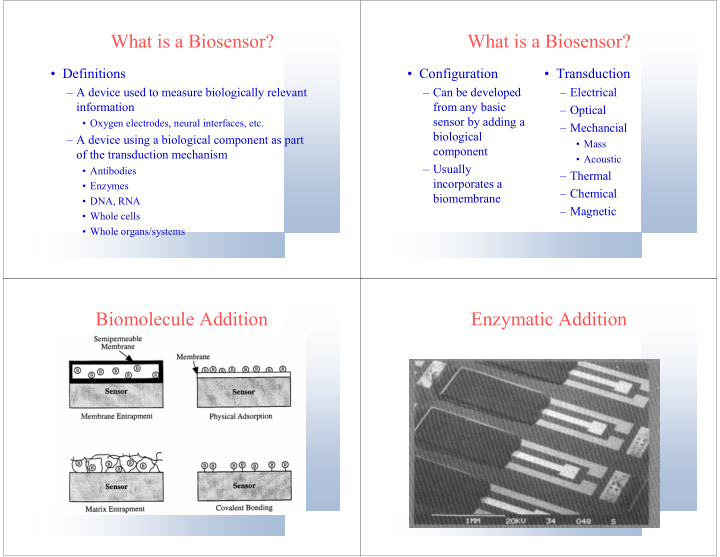



What is a Biosensor? What is a Biosensor? • Definitions • Configuration • Transduction – A device used to measure biologically relevant – Can be developed – Electrical information from any basic – Optical sensor by adding a • Oxygen electrodes, neural interfaces, etc. – Mechancial biological – A device using a biological component as part • Mass component of the transduction mechanism • Acoustic – Usually • Antibodies – Thermal incorporates a • Enzymes – Chemical biomembrane • DNA, RNA – Magnetic • Whole cells • Whole organs/systems Biomolecule Addition Enzymatic Addition
Calorimetric Biosensors Thermopile • Rely on biological molecules for transduction or detection • Enzymes (or even cells) immobilized on a surface • Enzymes catalyze a reaction which generates heat • Heat is proportional to amount of substrate present Field Effect Transistors Field Effect Transistor • Current from source to drain related to gate voltage • Application of membranes to gate allows selective measurements • Problems as biosensors – i) Membrane adhesion – ii) pH sensitivity – iii) Drift – iv) Coatings can help eliminate all – v) Nonlinear
ISFET Arrays • Advantages • Disadvantages – Repetitive information – Data processing • Increased confidence – Cross talk • Averaging – Fabrication and – Variety of information Packaging • Multiple analytes – General complexity • Multiple characterisitics – Amplification – Spatial resolution Natural Biosensor Arrays Electronic Nose • Nose • Significant interest • Pattern recognition • Usually an array of – Mapping • Tongue sensors – Vector analysis • Eyes – Fuzzy logic • Detect odors • Touch – Neural networks • Detect volatile • Combined senses chemicals – Must adsorb to surface • Data processing?
Typical Array Spatial Sensor Array Layout • Mulitple analytes on closely spaced array Sensor array on 30mm x 30mm Si substrate area • Vias for electrical connection • Membrane for selectivity Neural Recording Microelectrode Arrays Arrays for Monitoring Cell • Types • Design Issues Physiology • Future Work
Michigan Array 2 Michigan Arrays Stanford Arrays Packaging
Flexible Polymer Electrodes Regeneration Array Regeneration Array Fabrication Stanford Cell Arrays • Arrays of electrodes surrounding holes • Nerves grow through holes and connect on opposite side • Requires injury to animal Source: Kovacs at Stanford
Neuro Chip Cultured Neural Networks • Neurons cultured in wells and axons • ITO electrodes with neurons escape through small holes growing over them • Synapses can be monitored • Easily monitor synapses • Electronics built in between cells Neural Cell Drug Screening Measurement Neurons grow in small gaps Cells constrained to grow over sensing electrodes • Neuron acts as gate on FET Drug can be introduced through • Cell must migrate to sensor perpendicular microchannels
Artificial Silicon Retina Arrays Tactile Displays • Two layer polysilicon process with metallization • 3500 silicon photodiodes • Voltage applied and outer ring contracts • Each connected to stimulating electrode • Polyimide in center bubbles up to • Shown to generate neural response signal Enzyme Bioreactor
Recommend
More recommend